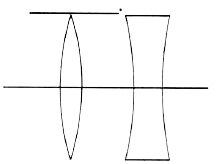A convex lens and a concave lens are kept separated by a distance d. If they are placed in close contact, the focal length of the combination
will become zero
will increase
will decrease
will remain constant
The correct Answer is:C
To solve the problem of finding the focal length of the combination of a convex lens and a concave lens when they are placed in close contact, we can follow these steps:
Step 1: Understand the Focal Lengths of Individual Lenses
Let:
- f1 = focal length of the convex lens (positive value)
- f2 = focal length of the concave lens (negative value)
Step 2: Use the Lens Formula for Two Lenses in Contact
When two lenses are placed in contact, the formula for the combined focal length fc of the system is given by:
1fc=1f1+1f2
Step 3: Substitute the Values
Substituting f2 as a negative value (since it is a concave lens):
1fc=1f1+1−f2
This simplifies to:
1fc=1f1−1|f2|
where |f2| is the absolute value of the focal length of the concave lens.
Step 4: Rearranging the Equation
Rearranging gives:
1fc=1f1−1|f2|
Step 5: Finding the Combined Focal Length
To find fc, take the reciprocal:
fc=1(1f1−1|f2|)
Step 6: Analyze the Effect of Distance
If the distance d between the lenses is zero (i.e., they are in close contact), the focal length fc will be determined solely by the individual focal lengths f1 and f2. If |f2| is sufficiently large compared to f1, the combined focal length fc will be less than f1.
Conclusion
Thus, when the convex lens and concave lens are placed in close contact, the focal length of the combination will decrease compared to when they are separated by a distance d.
Let:
- f1 = focal length of the convex lens (positive value)
- f2 = focal length of the concave lens (negative value)
When two lenses are placed in contact, the formula for the combined focal length fc of the system is given by:
1fc=1f1+1f2
Substituting f2 as a negative value (since it is a concave lens):
1fc=1f1+1−f2
This simplifies to:
1fc=1f1−1|f2|
where |f2| is the absolute value of the focal length of the concave lens.
Rearranging gives:
1fc=1f1−1|f2|
To find fc, take the reciprocal:
fc=1(1f1−1|f2|)
If the distance d between the lenses is zero (i.e., they are in close contact), the focal length fc will be determined solely by the individual focal lengths f1 and f2. If |f2| is sufficiently large compared to f1, the combined focal length fc will be less than f1.
Thus, when the convex lens and concave lens are placed in close contact, the focal length of the combination will decrease compared to when they are separated by a distance d.
Topper's Solved these Questions
- BOOK - MARVEL PUBLICATIONCHAPTER - RAY OPTICS (MIRRORS, LENSES AND OPTICAL INSTRUMENTS)EXERCISE - TEST YOUR GRASP10videos
RAY OPTICS (MIRRORS, LENSES AND OPTICAL INSTRUMENTS)
- BOOK - MARVEL PUBLICATIONCHAPTER - MEASUREMENTS EXERCISE - TEST YOUR GRASP10videos
MEASUREMENTS
- BOOK - MARVEL PUBLICATIONCHAPTER - REFRACTION OF LIGHT EXERCISE - Test Your Grasp10videos
REFRACTION OF LIGHT
Similar Questions
A convex lens of power 5 D and a concave lens of power 7.5 D are placed in contact with each other. What is the:
a) power of this combination of lenses?
b) focal length of this combination of lenses?View SolutionIf a convex lens of focal length 20 cm and a concave lens of focal length 30 cm are kept in contract with each other.
What will be the focal length of the combination ?View Solution
Knowledge Check
- Question 1 - Select One
A convex lens of focal length x and a concave lens of focal length y are placed in contact. The focal length of the combination is
A(x + y)B(x - y)Cxyx+yDxyy−x - Question 2 - Select One
A convex lens of focal length A and a concave lens of focal length B are placed in contact. The focal length of the combination is
A(A+B)B(A-B)CAB(A+B)DAB(B−A) - Question 3 - Select One
A comvex lens and a concave lens are placed in contact. The ratio of magnitude of the power of the convex lens to that of the concave lens is 4:3. If the focal length of the convex lens is 12 cm, then the focal length of the combination will be
A16 cmB24 cmC32 cmD48 cm
If the convex lens of focal length 10 cm and a concave lens of focal length 50 cm are kept in contact with each other.
What will be the focal length of the combination ?View SolutionA convex lens and a concave lens, each of focal length 10 cm, are kept separated by a distance of 2 cm as shown in the figure. If the light is incident from left, the combination of lenses will be :
 View Solution
View SolutionTwo thin lenses, aone convex of focal length 10 cm and other concave lens are kept in contact to form a composite lens of focal length 13 cm . If the combination acts as a converging lense the focal length of second lens is
View SolutionAssertion:A convex lens and a concave lens are kept in contact. They will behave as a diverging lens if focal length of convex lens is more.
Reason: Power of a concave lens is always less than the power of a convex lens, as power of concave lens is negative whereas power of convex lens is positive.View SolutionA convex lens of focal length 'f' is placed in contact with a concave lens of the same focal length. The equivalent focal length of the combination is
View Solution

